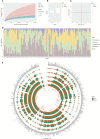Comparison of the ocular surface microbiota between thyroid-associated ophthalmopathy patients and healthy subjects
- PMID: 35959376
- PMCID: PMC9360483
- DOI: 10.3389/fcimb.2022.914749
Comparison of the ocular surface microbiota between thyroid-associated ophthalmopathy patients and healthy subjects
Abstract
Purpose: Thyroid-associated ophthalmopathy (TAO) is a chronic autoimmune disease. In this study, high-throughput sequencing was used to investigate the diversity and composition of the ocular microbiota in patients with TAO.
Methods: Patients with TAO did not receive treatment for the disease and did not have exposed keratitis. Patients with TAO (TAO group) and healthy individuals (control group) were compared. All samples were swabbed at the conjunctival vault of the lower eyelid. The V3 to V4 region of the 16S rDNA was amplified using polymerase chain reaction and sequenced on the Illumina HiSeq 2500 Sequencing Platform. Statistical analysis was performed to analyze the differences between the groups and the correlation between ocular surface microbiota and the disease. The ocular surface microbiota of patients and healthy individuals were cultured.
Results: The ocular surface microbiota structure of TAO patients changed significantly. The average relative abundance of Bacillus and Brevundimonas increased significantly in the TAO group. Corynebacterium had a significantly decreased relative abundance (P<0.05). Paracoccus, Haemophilus, Lactobacillus, and Bifidobacterium were positively correlated with the severity of clinical manifestations or disease activity (P<0.05). Bacillus cereus and other opportunistic pathogens were obtained by culture from TAO patients.
Conclusions: This study found that the composition of ocular microbiota in patients with TAO was significantly different from that in healthy individuals. The ocular surface opportunistic pathogens, such as Bacillus, Brevundimonas, Paracoccus, and Haemophilus in TAO patients, increase the potential risk of ocular surface infection. The findings of this study provide a new avenue of research into the mechanism of ocular surface in TAO patients.
Keywords: bacteria; high-throughput sequencing; ocular surface; ocular surface microbiota; thyroid-associated ophthalmopathy.
Copyright © 2022 Ji, Dong, Pu, Yang, Zhang, Ning, Ma, Kang, Xu and Sun.
Conflict of interest statement
The authors declare that the research was conducted in the absence of any commercial or financial relationships that could be construed as a potential conflict of interest.
Figures



Similar articles
-
Exploring gut microbiota and metabolite alterations in patients with thyroid-associated ophthalmopathy using high-throughput sequencing and untargeted metabolomics.Front Endocrinol (Lausanne). 2024 Jul 29;15:1413890. doi: 10.3389/fendo.2024.1413890. eCollection 2024. Front Endocrinol (Lausanne). 2024. PMID: 39135625 Free PMC article.
-
Composition and Diversity of the Ocular Surface Microbiota in Patients With Blepharitis in Northwestern China.Front Med (Lausanne). 2021 Dec 7;8:768849. doi: 10.3389/fmed.2021.768849. eCollection 2021. Front Med (Lausanne). 2021. PMID: 34950683 Free PMC article.
-
[Research advances in the pathogenesis of dry eye in thyroid associated ophthalmopathy].Zhonghua Yan Ke Za Zhi. 2025 Feb 14;61(2):156-160. doi: 10.3760/cma.j.cn112142-20240319-00120. Zhonghua Yan Ke Za Zhi. 2025. PMID: 39939012 Review. Chinese.
-
Defining the normal core microbiome of conjunctival microbial communities.Clin Microbiol Infect. 2016 Jul;22(7):643.e7-643.e12. doi: 10.1016/j.cmi.2016.04.008. Epub 2016 Apr 19. Clin Microbiol Infect. 2016. PMID: 27102141
-
Current concepts in the molecular pathogenesis of thyroid-associated ophthalmopathy.Invest Ophthalmol Vis Sci. 2014 Mar 20;55(3):1735-48. doi: 10.1167/iovs.14-14002. Invest Ophthalmol Vis Sci. 2014. PMID: 24651704 Free PMC article. Review.
Cited by
-
Multi-Omics Approaches to Discover Biomarkers of Thyroid Eye Disease: A Systematic Review.Int J Biol Sci. 2024 Nov 11;20(15):6038-6055. doi: 10.7150/ijbs.103977. eCollection 2024. Int J Biol Sci. 2024. PMID: 39664569 Free PMC article.
-
Multi-cohort analysis identifying core ocular surface microbiome and bacterial alterations in eye diseases.Eye (Lond). 2025 May;39(7):1276-1285. doi: 10.1038/s41433-024-03589-x. Epub 2025 Jan 20. Eye (Lond). 2025. PMID: 39833573
-
Alterations of conjunctival microbiota associated with orthokeratology lens wearing in myopic children.BMC Microbiol. 2023 Dec 13;23(1):397. doi: 10.1186/s12866-023-03042-1. BMC Microbiol. 2023. PMID: 38087200 Free PMC article.
-
Comparison of Conjunctival Sac Microbiome between Low and High Myopic Eyes.J Microbiol. 2023 May;61(5):571-578. doi: 10.1007/s12275-023-00045-5. Epub 2023 Apr 21. J Microbiol. 2023. PMID: 37084130
-
Alterations of ocular surface microbiome in glaucoma and its association with dry eye.J Med Microbiol. 2025 May;74(5):002013. doi: 10.1099/jmm.0.002013. J Med Microbiol. 2025. PMID: 40359128 Free PMC article.
References
Publication types
MeSH terms
LinkOut - more resources
Full Text Sources

